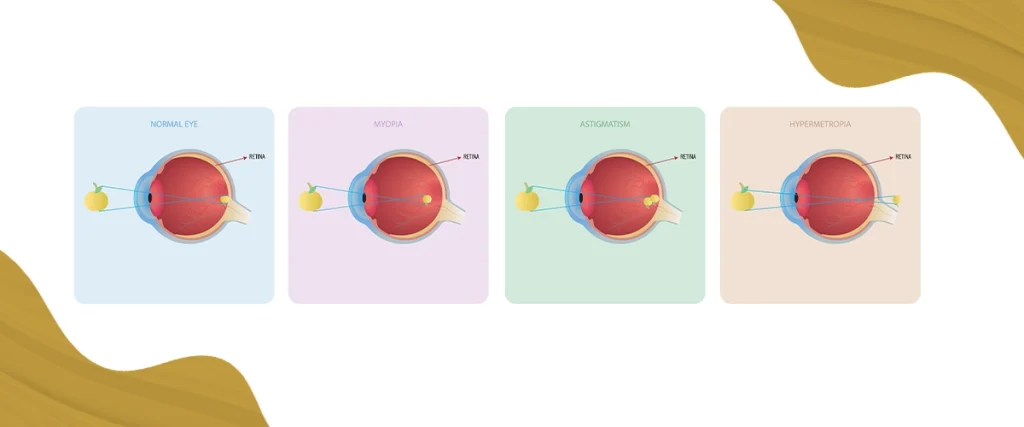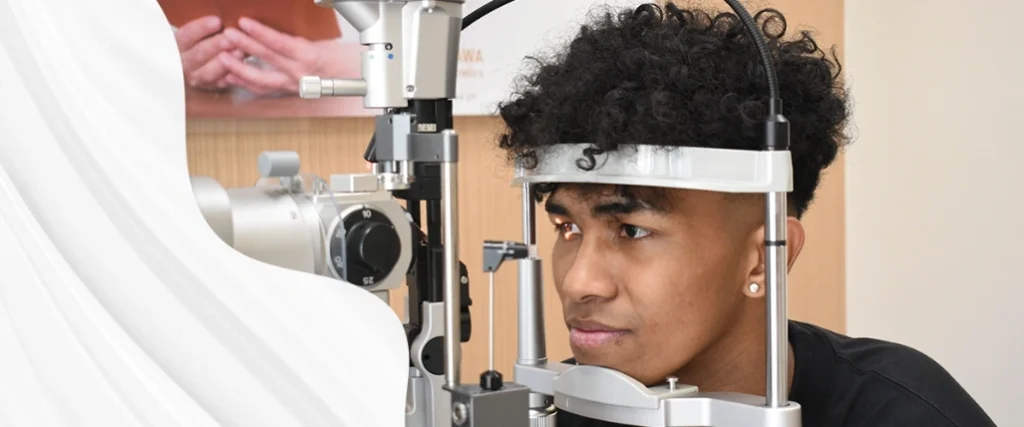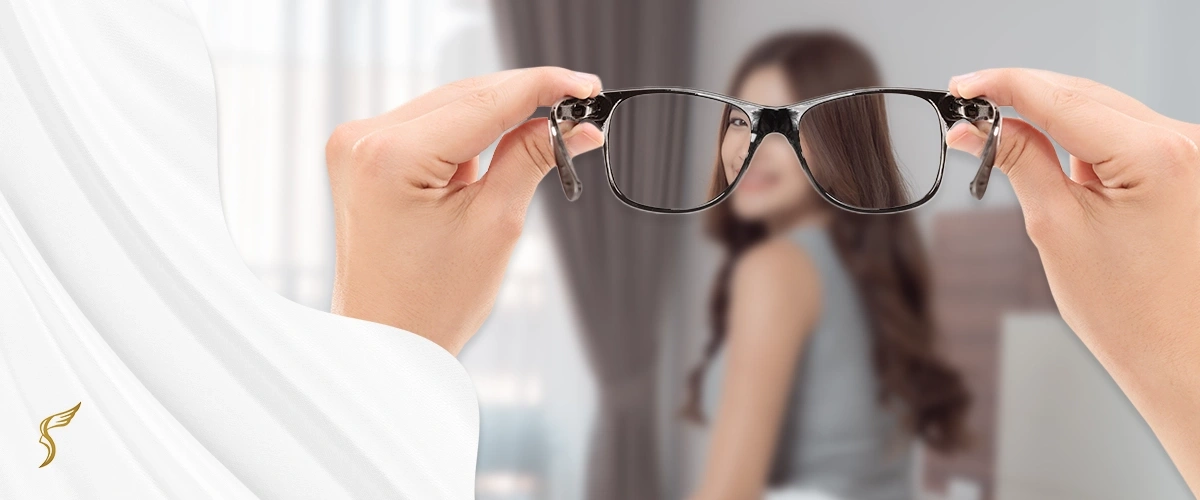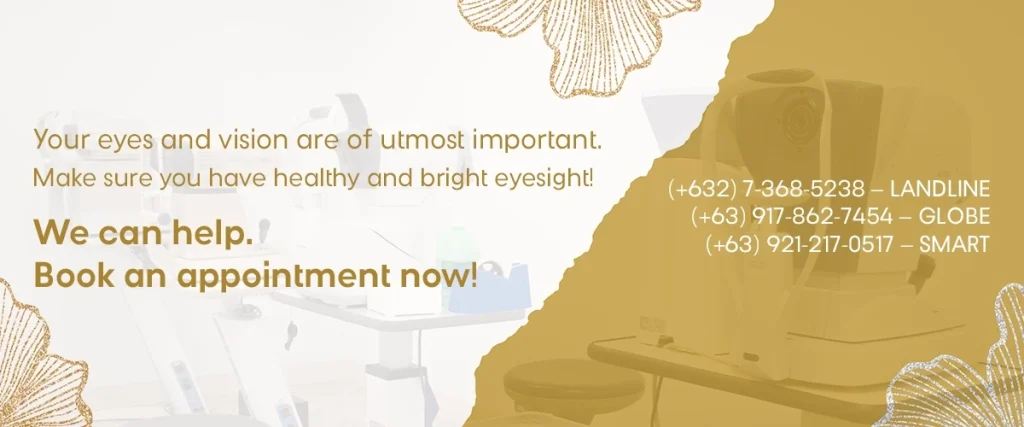Vision is one of our most precious senses, allowing us to navigate the world, connect with others, and appreciate its beauty. When our eyes cannot properly focus light, the clarity of this vision can be compromised. This inability to focus light precisely onto the retina, the light-sensitive tissue at the back of the eye, is known as a refractive error. It results in blurred vision, affecting daily activities and overall quality of life.
The impact of uncorrected refractive errors extends far beyond individual inconvenience. It is a significant global public health concern. According to the World Health Organization (WHO) and the International Agency for the Prevention of Blindness (IAPB), uncorrected refractive errors remain the leading cause of vision impairment worldwide. An estimated 153 million people globally suffer from visual impairment due to uncorrected refractive errors, underscoring the critical need for awareness, diagnosis, and effective correction.

Types of Refractive Errors
Refractive errors manifest in several distinct forms, each affecting vision in a unique way. Understanding these types is the first step toward effective management.
Myopia (Nearsightedness)
Myopia, commonly known as nearsightedness, is a condition where close objects appear clear, but distant objects look blurry. This occurs when the eyeball is too long from front to back, or when the cornea (the clear front surface of the eye) or the lens inside the eye is too steeply curved. Light entering the eye focuses in front of the retina, rather than directly on it.
The prevalence of myopia is rising at an alarming rate globally. Recent projections from the Brien Holden Vision Institute indicate that by 2050, nearly half of the world’s population, approximately 5 billion people, will be myopic. A significant portion of these, around 1 billion, are projected to have high myopia. Regions like East Asia, including the Philippines, are experiencing particularly high rates. Symptoms include difficulty seeing distant objects, squinting, and eye strain. High myopia also carries increased risks of serious eye conditions such as retinal detachment, glaucoma, and myopic macular degeneration.
Hyperopia (Farsightedness)
In contrast to myopia, hyperopia, or farsightedness, typically allows for clear distance vision, but near objects may appear blurry, especially as one ages or if the hyperopia is significant. This condition arises when the eyeball is too short, or the cornea or lens is too flat. As a result, light focuses behind the retina.
Individuals with hyperopia may experience difficulty with close-up tasks, eye strain, headaches, and fatigue, particularly after prolonged reading or computer use. In children, significant uncorrected hyperopia can sometimes lead to amblyopia, also known as “lazy eye.”
Astigmatism
Astigmatism causes blurred or distorted vision at all distances. This occurs because the cornea or the lens has an irregular, football-like shape rather than a perfectly spherical one. This irregular curvature prevents light from focusing uniformly on the retina, leading to multiple focal points.
Symptoms of astigmatism include distorted vision, eye strain, headaches, and difficulty with night vision, often manifesting as halos or glare around lights. Astigmatism is a very common refractive error and frequently co-occurs with either myopia or hyperopia.
Presbyopia
Presbyopia is an age-related condition that affects nearly everyone, typically beginning in the mid-40s. It is the natural loss of the eye’s ability to focus on near objects. This occurs because the eye’s natural lens, which is responsible for changing shape to focus on different distances, gradually hardens and loses its flexibility over time.
Common symptoms include difficulty reading small print, needing to hold reading material further away, eye strain, and headaches after close-up tasks. The global prevalence of presbyopia is estimated to be over 1.8 billion people, underscoring its universal impact as a natural part of the aging process.
Causes and Risk Factors
While the exact mechanisms behind refractive errors are complex, several factors contribute to their development. Genetics play a significant role; if your parents have refractive errors, especially myopia, you are more likely to develop them.
Environmental factors are also increasingly recognized, particularly in the context of myopia. Prolonged near-work activities, such as reading, studying, and extensive use of digital devices, coupled with reduced time spent outdoors, are strongly linked to the development and progression of myopia. Studies on digital eye strain highlight the impact of modern lifestyles on our vision. Age is a primary factor for presbyopia, as it is a natural part of the aging process. Certain medical conditions, such as diabetes or the development of cataracts, can also influence refractive error.
Symptoms of Refractive Error
Recognizing the symptoms of refractive error is crucial for timely intervention. The most common symptom is blurred vision, which can affect distance, near, or both. Other indicators include recurrent headaches, persistent eye strain, and general eye fatigue. Many individuals find themselves squinting to try and see clearly. Difficulty with night driving, characterized by glare or halos around lights, is also a frequent complaint. In some less common instances, double vision may occur. Difficulty concentrating, especially during tasks requiring visual focus, can also be a symptom.

Diagnosis: How Refractive Errors Are Detected
Detecting refractive errors requires a comprehensive eye examination performed by a qualified eye care professional. Regular check-ups are paramount for early detection and monitoring. The diagnostic process typically involves several key steps:
- Visual Acuity Test: This widely recognized test uses a Snellen chart to measure how clearly you see at various distances.
- Refraction: This is the core of determining your prescription. Objective refraction uses instruments like auto refractors to estimate your prescription, while subjective refraction involves a phoropter, where you provide feedback on which lens combination offers the clearest vision.
- Slit-Lamp Examination: This allows the eye care professional to examine the health of the front structures of your eye, including the cornea, iris, and lens.
- Pupil Dilation: In some cases, eye drops are used to dilate the pupils, providing a better, more comprehensive view of the retina and optic nerve at the back of the eye.
Treatment and Correction Options
Fortunately, a range of effective treatments and correction options are available to manage refractive errors and restore clear vision.
Eyeglasses
Eyeglasses are the most common and straightforward method of vision correction. They consist of lenses precisely crafted to bend light in a way that allows it to focus correctly on the retina. Various types are available, including single vision lenses for one specific distance, bifocals for both near and far vision, and progressive lenses that offer a seamless transition across multiple focal distances. Eyeglasses are non-invasive, easy to use, and come in a wide array of styles, though some individuals may find them cumbersome or have cosmetic concerns.
Contact Lenses
Contact lenses are small, corrective lenses worn directly on the eye’s surface. They offer a natural field of vision and are often preferred for their cosmetic appeal and convenience, especially for active lifestyles. Types include soft lenses, rigid gas permeable (RGP) lenses, daily disposables, and extended wear options. Specialized contact lenses like toric lenses correct astigmatism, while multifocal contact lenses address presbyopia. Proper hygiene is crucial with contact lenses to minimize the risk of infection.
Refractive Surgery
Refractive surgery offers a more permanent solution by reshaping the cornea or implanting lenses to correct vision. These procedures aim to reduce or eliminate the need for eyeglasses or contact lenses.
- LASIK (Laser-Assisted In Situ Keratomileusis): This is the most widely performed refractive surgery.
- TransPRK (Photorefractive Keratectomy): A surface ablation procedure, often suitable for those not ideal for LASIK.
- ICL (Implantable Collamer Lens): An option for individuals with higher prescriptions or those not suitable for laser surgery.
Eligibility for refractive surgery depends on factors such as stable prescription, good overall eye health, and age. Modern refractive surgeries, particularly LASIK, boast high patient satisfaction rates, often exceeding 95%, with studies consistently showing excellent visual outcomes and reduced dependence on corrective eyewear. Continuous advancements in technology have significantly improved the safety and precision of these procedures.
Refractive Errors in the Philippines: A Closer Look
Access to eye care in the Philippines varies by region. Urban areas like Metro Manila have numerous clinics and optical shops, but rural areas often lack basic services. Many Filipinos either ignore vision problems or rely on self-medication without proper diagnosis.
Efforts are underway to improve eye health awareness, but gaps still exist. Organizations like Shinagawa Lasik & Aesthetics aim to bridge this gap by offering both advanced surgical solutions and community outreach programs to promote vision health.
Taking Care of Refractive Errors
Refractive errors are common vision conditions that can significantly impact daily life if left uncorrected. From myopia and hyperopia to astigmatism and presbyopia, understanding these conditions and the array of available correction options is the first step towards achieving clear and comfortable vision.
Regular, comprehensive eye examinations are paramount to maintaining optimal vision health throughout your life.
At Shinagawa Lasik & Aesthetics, we are dedicated to providing world-class eye care solutions, utilizing advanced technology and expert medical professionals to help you achieve your best possible vision. We believe in empowering our patients with knowledge and offering personalized treatment plans, ensuring a future of clear sight. We invite you to explore our services and learn more about how we can assist you on your journey to visual clarity.
For inquiries, questions, and appointments, call our Patient Care Lines:
🖥 Talk to our Consultants via Livechat: https://direct.lc.chat/6329011/
📱 Instagram: https://instagram.com/shinagawa_ph/
Citations and Resources
Shinagawa LASIK & Aesthetics strives to provide accurate and reliable information regarding LASIK procedures and eye health. We utilize primary sources to support our content, including peer-reviewed scientific studies, data from reputable medical organizations, and expert opinions. We also reference established publications and research where appropriate.
Our commitment to evidence-based information ensures that you receive trustworthy and up-to-date details to make informed decisions about your eye care.
Resources Used in This Article
- The Fred Hollows Foundation. “Uncorrected Refractive Error, https://www.hollows.org/en-US/eye-health/diseases-and-conditions/uncorrected-refractive-error/“
- Optometry Times. “World Health Assembly panel to shine light on global pervasiveness of uncorrected refractive error, https://www.optometrytimes.com/view/world-health-assembly-panel-to-shine-light-on-global-pervasiveness-of-uncorrected-refractive-error“
- American Academy of Ophthalmology. “Need to Check for Uncorrected Refractive Errors, https://www.aao.org/eyenet/article/need-to-check-for-uncorrected-refractive-errors“
- Research Gate. “Impact of refractive error on quality of life: a qualitative study, https://www.researchgate.net/publication/315778292_Impact_of_refractive_error_on_quality_of_life_a_qualitative_study“
- PubMed. “Refractive errors, https://pmc.ncbi.nlm.nih.gov/articles/PMC5143802/“


